The Cambridge History of China. Vol. 06. Alien Regimes and Border States, 907-1368
Подождите немного. Документ загружается.


THE REIGN OF TUGH TEMCR 543
as his main motive for joining the movement. Some may have been motivated
by the desire to avenge Shidebala's murder,
2
'
6
whereas others joined the
movement because they disliked or felt threatened by Daula-shah and Toghto
and Ongchan.
2
'
7
In its initial stage, the movement should therefore be consid-
ered an attempt by Darmabala's descendants to restore rule. But because by
this time there were no surviving heirs of Ayurbarwada, restoring the sons of
Khaishan to the throne became the movement's rallying cry.
2
'
8
El Temiir organized the movement as soon as Yesiin Temiir khaghan had
fallen ill in the late spring of 1328, planning to stage a coup d'etat simulta-
neously in the two capitals. Though relatively junior in rank, El Temiir
enjoyed the advantage of being in control of the imperial guards in Ta-tu
during the khaghan's absence, for it was normal Yuan practice for the chief
officials of the Bureau of Military Affairs and of the Secretariat to accompany
the khaghan on his annual trip to the summer capital. Collaborating with
Aratnashiri (A-la-te-na-shih-li), the prince of Hsi-an who had been assigned
to take charge of the capital during the khaghan's absence,
239
El Temiir
successfully stormed the palace at dawn on 8 September, rounding up
Ubaidallah and the remaining officials of the administration in Ta-tu. In
Shang-tu, however, eighteen of El Temiir's collaborators were discovered and
executed. Thus the two capitals fell into the hands of opposing camps.
After seizing control of Ta-tu, El Temiir immediately organized a tempo-
rary government and notified Tugh Temiir in Chiang-ling and Bayan of the
Merkid tribe in Ho-nan.
24
° Bayan, a former junior aide to Khaishan in the
steppe wars, emerged as another important figure in the restoration.
241
As
the manager of governmental affairs of the Ho-nan Branch Secretariat, Bayan
was able to seize control of that strategically located province, raise consider-
able armies and funds, and personally escort Tugh Temiir to Ta-tu, where
Tugh Temiir was enthroned on 16 October, promising to abdicate in favor of
Khoshila, his elder brother, when he arrived from Central Asia.
In the ensuing conflict, the loyalists at Shang-tu had a more just cause, for
they were supporting the designated heir of the late khaghan. This moral
236 Jen Su-ko, one of
Shidebala's
former
confidants, is
said
to
have
initiated
the
idea
of
a revolt
to
avenge
Shidebala's
murder. He
discussed this idea with
Su-su, a
Uighur
and
former
assistant director
of the
right
of the
Hu-kuang Branch
Secretariat,
and
persuaded
El
Temiir
to
lead
the
movement
even before
Yesun Temiir's
death. See YS, 184, pp. 4235-7.
237 YS, 32, p. 704.
Daula-shah
is
said
to
have arrogated power
to
himself
and to
have
protected Muslim
merchants
and
corrupt
officials. See YS, 32, p. 707; 182, p. 4194; 176, p. 4112.
238 On the
heirs
of
Ayurbarwada,
see Hambis, Le
chapitrt cvii
du
Yuan
cht, p. 138.
239
Aratnashiri
was the son of Tura, the
prince
of Yueh; see Hambis,
Le chapitrt cvii
du
Yuanche,
pp. 57—
8, 61-2.
240 YS, 31, pp. 694-5; 3
2
. PP- 704-5; 138, PP- 3326-7.
241 On the
Merkid
Bayan, see YS, 138, pp. 3335-9; Ma
Tsu-ch'ang,
Ma
Shih-t'itn wen
chi,
14, pp. ia—
5a;
Louis
Hambis,
"Notes prlliminaires
a une
biographic
de
Bayan
le
Markit,"Journal
Aiiatiquc,
241
(1955), pp. 215-48; Dardess,
Conquerors
and
Confucians,
pp. 53—74.
Cambridge Histories Online © Cambridge University Press, 2008
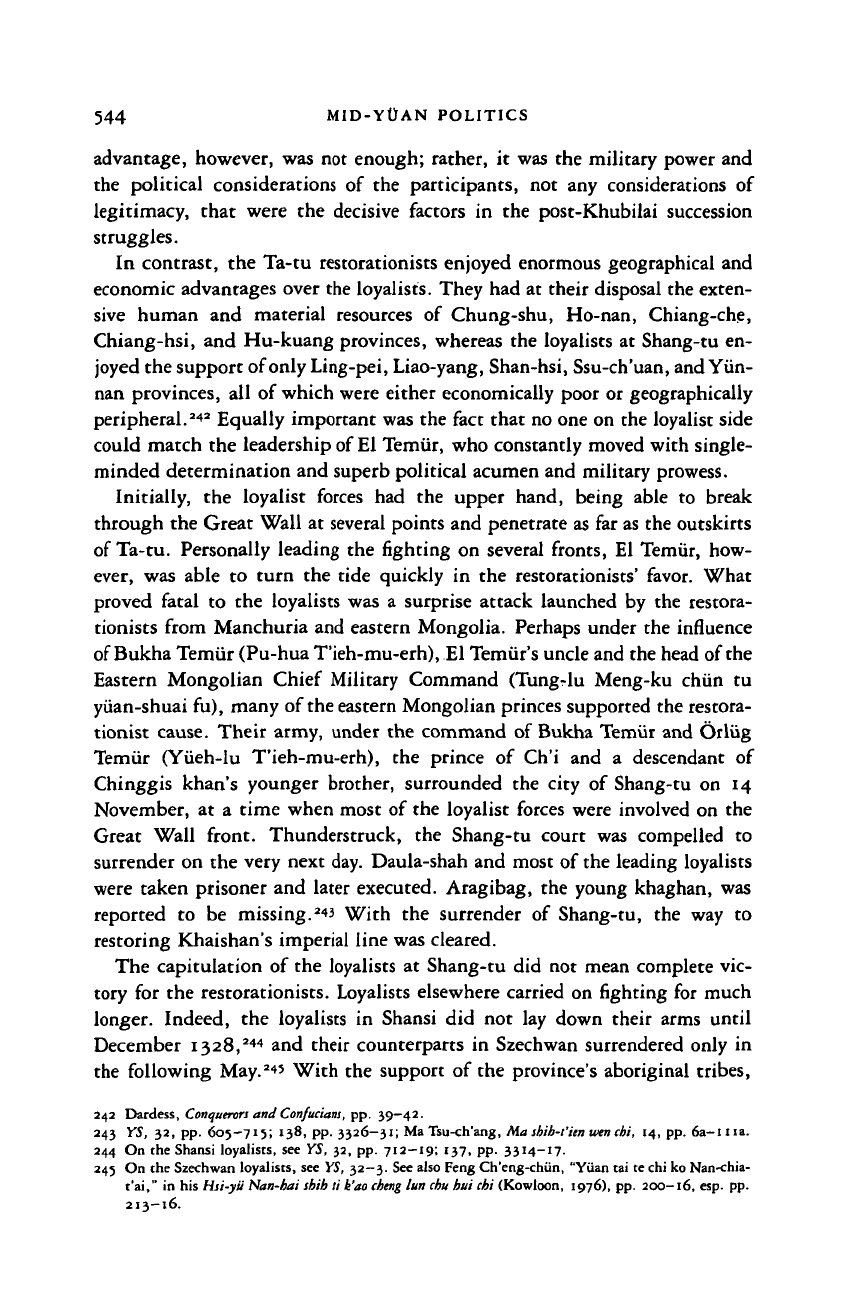
544 MID-YOAN POLITICS
advantage, however, was not enough; rather, it was the military power and
the political considerations of the participants, not any considerations of
legitimacy, that were the decisive factors in the post-Khubilai succession
struggles.
In contrast, the Ta-tu restorationists enjoyed enormous geographical and
economic advantages over the loyalists. They had at their disposal the exten-
sive human and material resources of Chung-shu, Ho-nan, Chiang-che,
Chiang-hsi, and Hu-kuang provinces, whereas the loyalists at Shang-tu en-
joyed the support of only Ling-pei, Liao-yang, Shan-hsi, Ssu-ch'uan, and Yun-
nan provinces, all of which were either economically poor or geographically
peripheral.
242
Equally important was the fact that no one on the loyalist side
could match the leadership of El Temiir, who constantly moved with single-
minded determination and superb political acumen and military prowess.
Initially, the loyalist forces had the upper hand, being able to break
through the Great Wall at several points and penetrate as far as the outskirts
of Ta-tu. Personally leading the fighting on several fronts, El Temiir, how-
ever, was able to turn the tide quickly in the restorationists' favor. What
proved fatal to the loyalists was a surprise attack launched by the restora-
tionists from Manchuria and eastern Mongolia. Perhaps under the influence
of Bukha Temiir (Pu-hua T'ieh-mu-erh), El Temiir's uncle and the head of the
Eastern Mongolian Chief Military Command (Tungrlu Meng-ku chiin tu
yiian-shuai fu), many of
the
eastern Mongolian princes supported the restora-
tionist cause. Their army, under the command of Bukha Temiir and Orliig
Temiir (Yiieh-lu T'ieh-mu-erh), the prince of Ch'i and a descendant of
Chinggis khan's younger brother, surrounded the city of Shang-tu on 14
November, at a time when most of the loyalist forces were involved on the
Great Wall front. Thunderstruck, the Shang-tu court was compelled to
surrender on the very next day. Daula-shah and most of the leading loyalists
were taken prisoner and later executed. Aragibag, the young khaghan, was
reported to be missing.
24
' With the surrender of Shang-tu, the way to
restoring Khaishan's imperial line was cleared.
The capitulation of the loyalists at Shang-tu did not mean complete vic-
tory for the restorationists. Loyalists elsewhere carried on fighting for much
longer. Indeed, the loyalists in Shansi did not lay down their arms until
December 1328,
244
and their counterparts in Szechwan surrendered only in
the following May.
245
With the support of the province's aboriginal tribes,
242
Dardcss,
Conqueron
and
Confucians,
pp. 39-42.
243 YS, 32, pp.
605—715;
138, pp. 3326—31; Ma
Tsu-ch'ang,
Ma
shib-i'ien wen
chi, 14, pp. 6a-l 11a.
244 On the
Shansi
loyalists,
see YS, 32, pp.
712—19;
137, pp.
3314-17.
245 On the
Szechwan
loyalists,
see YS, 32-3. See
also Feng
Ch'eng-chun,
"Yuan
tai te chi ko
Nan-chia-
t'ai,"
in his
Hsi-yii Nan-hai shih
li k'ao
cheng
tun cbu hut chi
(Kowloon,
1976),
pp.
200-16,
esp. pp.
213-16.
Cambridge Histories Online © Cambridge University Press, 2008
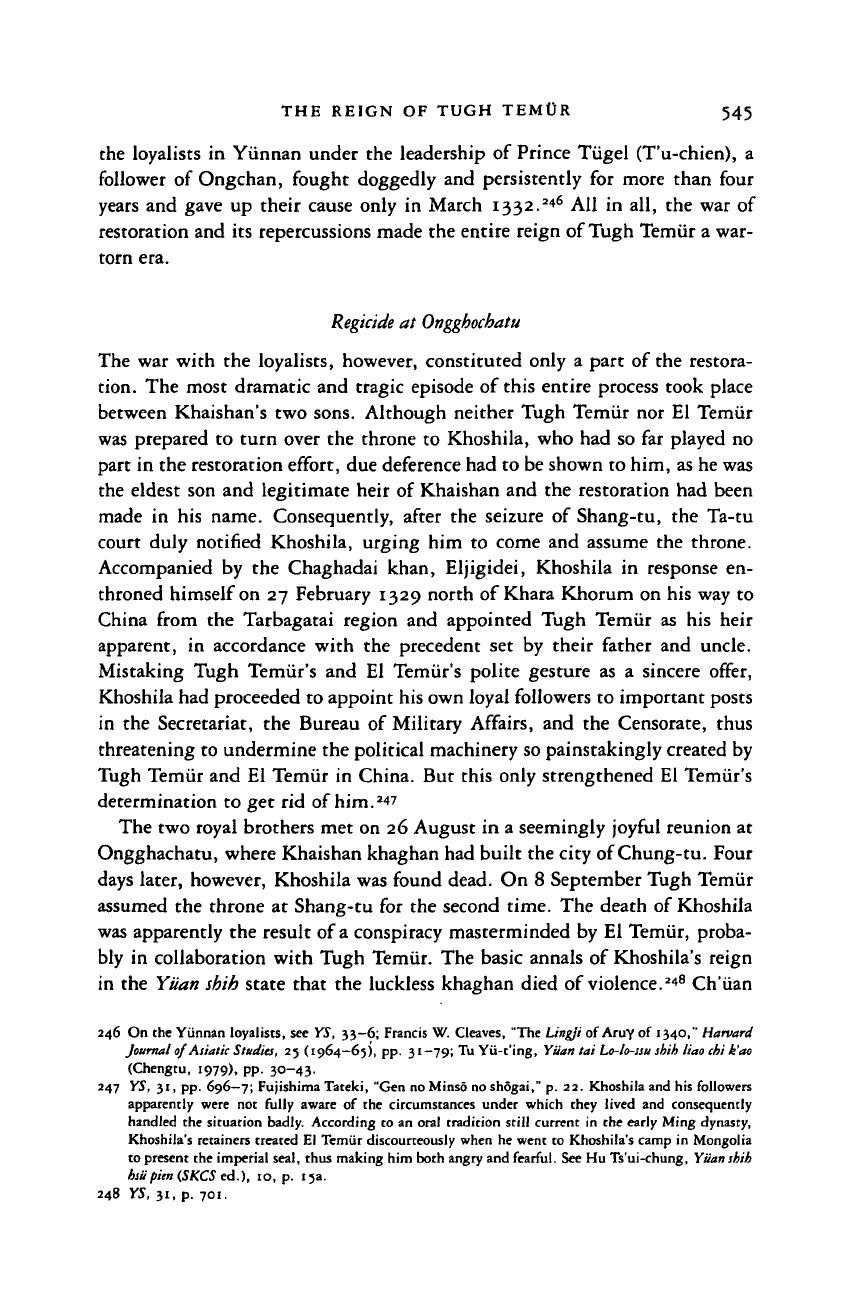
THE REIGN OF TUGH TEMOR 545
the loyalists in Yunnan under the leadership of Prince Tiigel (T'u-chien), a
follower of Ongchan, fought doggedly and persistently for more than four
years and gave up their cause only in March 1332.
2
+
6
All in all, the war of
restoration and its repercussions made the entire reign of Tugh Temiir a war-
torn era.
Regicide at Ongghochatu
The war with the loyalists, however, constituted only a part of the restora-
tion. The most dramatic and tragic episode of this entire process took place
between Khaishan's two sons. Although neither Tugh Temiir nor El Temiir
was prepared to turn over the throne to Khoshila, who had so far played no
part in the restoration effort, due deference had to be shown to him, as he was
the eldest son and legitimate heir of Khaishan and the restoration had been
made in his name. Consequently, after the seizure of Shang-tu, the Ta-tu
court duly notified Khoshila, urging him to come and assume the throne.
Accompanied by the Chaghadai khan, Eljigidei, Khoshila in response en-
throned himself on 27 February 1329 north of Khara Khorum on his way to
China from the Tarbagatai region and appointed Tugh Temiir as his heir
apparent, in accordance with the precedent set by their father and uncle.
Mistaking Tugh Temiir's and El Temiir's polite gesture as a sincere offer,
Khoshila had proceeded to appoint his own loyal followers to important posts
in the Secretariat, the Bureau of Military Affairs, and the Censorate, thus
threatening to undermine the political machinery so painstakingly created by
Tugh Temiir and El Temiir in China. But this only strengthened El Temiir's
determination to get rid of him.
2
*?
The two royal brothers met on 26 August in a seemingly joyful reunion at
Ongghachatu, where Khaishan khaghan had built the city of Chung-tu. Four
days later, however, Khoshila was found dead. On 8 September Tugh Temiir
assumed the throne at Shang-tu for the second time. The death of Khoshila
was apparently the result of a conspiracy masterminded by El Temiir, proba-
bly in collaboration with Tugh Temiir. The basic annals of Khoshila's reign
in the Yuan shih state that the luckless khaghan died of violence.
248
Ch'iian
246 On the Yunnan loyalists, see YS, 33—6; Francis W. Cleaves, "The Lingji of Amy of 1340," Harvard
Journal of Asiatic Studies, 25 (1964—65), pp. 31-79; Tu Vii-t'ing, Yuan tai
Lo-lo-ssu
shih liao chi k'ao
(Chengtu, 1979), pp. 30-43.
247 YS, 31, pp. 696—7; Fujishima Tateki, "Gen no Minso no shogai," p. 22. Khoshila and his followers
apparently were not fully aware of the circumstances under which they lived and consequently
handled the situation badly. According to an oral tradition still current in the early Ming dynasty,
Khoshila's retainers treated El Temiir discourteously when he went to Khoshila's camp in Mongolia
to present the imperial seal, thus making him both angry and fearful. See Hu Ts'ui-chung, Yuan shih
hsiipirn (SKCS ed.), 10, p. 15a.
248 YS, 31, p. 701.
Cambridge Histories Online © Cambridge University Press, 2008
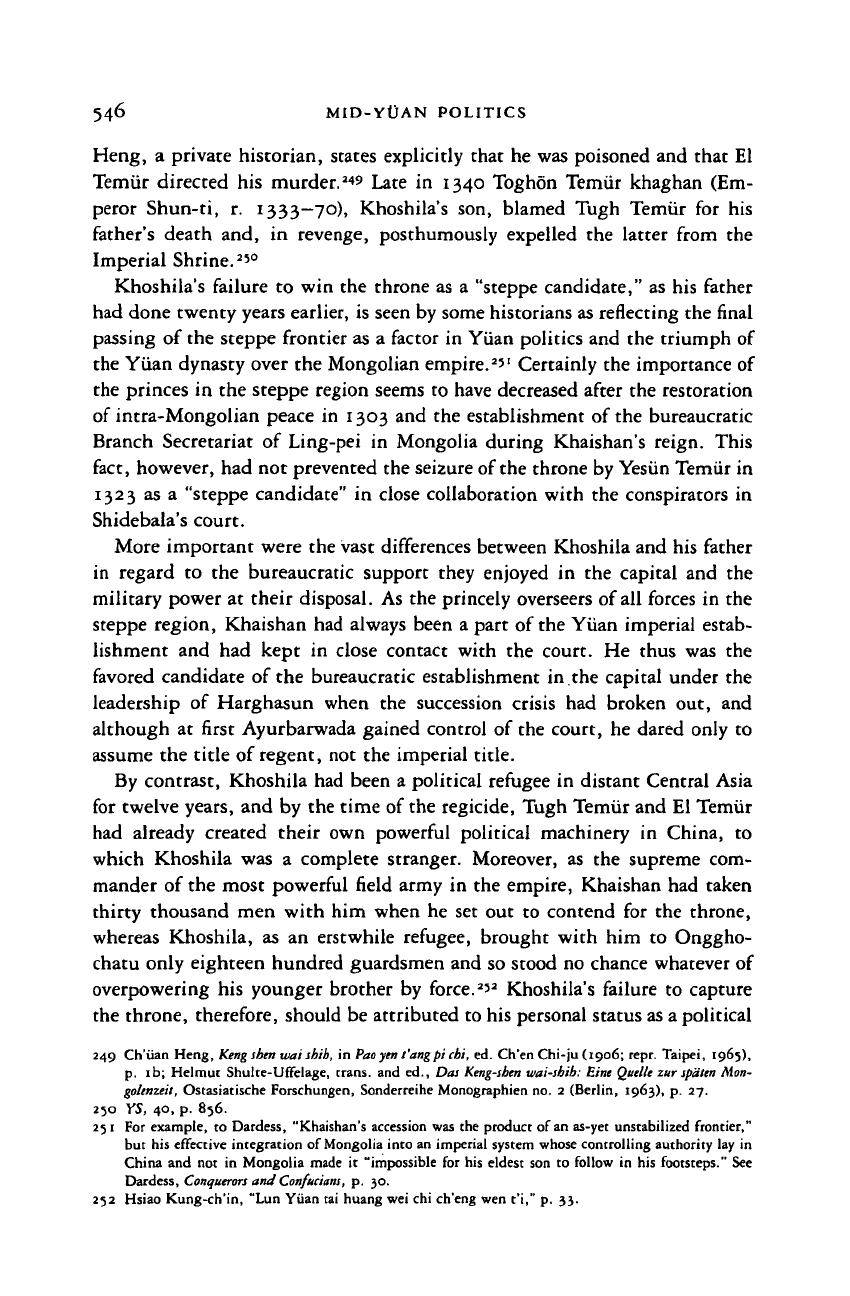
546 MID-YOAN POLITICS
Heng, a private historian, states explicitly that he was poisoned and that El
Temiir directed his murder.
249
Late in 1340 Toghon Temiir khaghan (Em-
peror Shun-ti, r. 1333-70), Khoshila's son, blamed Tugh Temiir for his
father's death and, in revenge, posthumously expelled the latter from the
Imperial Shrine.
2
'
0
Khoshila's failure to win the throne as a "steppe candidate," as his father
had done twenty years earlier, is seen by some historians as reflecting the final
passing of the steppe frontier as a factor in Yuan politics and the triumph of
the Yuan dynasty over the Mongolian empire.
2
'' Certainly the importance of
the princes in the steppe region seems to have decreased after the restoration
of intra-Mongolian peace in 1303 and the establishment of the bureaucratic
Branch Secretariat of Ling-pei in Mongolia during Khaishan's reign. This
fact, however, had not prevented the seizure of the throne by Yesiin Temiir in
1323 as a "steppe candidate" in close collaboration with the conspirators in
Shidebala's court.
More important were the vast differences between Khoshila and his father
in regard to the bureaucratic support they enjoyed in the capital and the
military power at their disposal. As the princely overseers of all forces in the
steppe region, Khaishan had always been a part of the Yuan imperial estab-
lishment and had kept in close contact with the court. He thus was the
favored candidate of the bureaucratic establishment in the capital under the
leadership of Harghasun when the succession crisis had broken out, and
although at first Ayurbarwada gained control of the court, he dared only to
assume the title of regent, not the imperial title.
By contrast, Khoshila had been a political refugee in distant Central Asia
for twelve years, and by the time of the regicide, Tugh Temiir and El Temiir
had already created their own powerful political machinery in China, to
which Khoshila was a complete stranger. Moreover, as the supreme com-
mander of the most powerful field army in the empire, Khaishan had taken
thirty thousand men with him when he set out to contend for the throne,
whereas Khoshila, as an erstwhile refugee, brought with him to Onggho-
chatu only eighteen hundred guardsmen and so stood no chance whatever of
overpowering his younger brother by force.
2
'
2
Khoshila's failure to capture
the throne, therefore, should be attributed to his personal status as a political
249 Ch'iian Heng,
Keng sben
wai
shih,
in
Poo yen
t'angpi cbi, ed. Ch'en Chi-ju (1906; repr. Taipei, 1965),
p.
ib; Helmut Shulte-Uffelage, trans, and ed., Das
Keng-shen
wai-sbih: Eim Quelle zur
spdten
Mon-
golenzeil, Ostasiatische Forschungen, Sonderreihe Monographien no. 2 (Berlin, 1963), p. 27.
250 YS, 40, p. 856.
231 For example, to Dardess, "Khaishan's accession was the product of an as-yet unstabilized frontier,"
but his effective integration of Mongolia into an imperial system whose controlling authority lay in
China and not in Mongolia made it "impossible for his eldest son to follow in his footsteps." See
Dardess,
Conquerors
and
Confucians,
p. 30.
252 Hsiao Kung-ch'in, "Lun Yuan tai huang wei chi ch'eng wen t'i," p. 33.
Cambridge Histories Online © Cambridge University Press, 2008
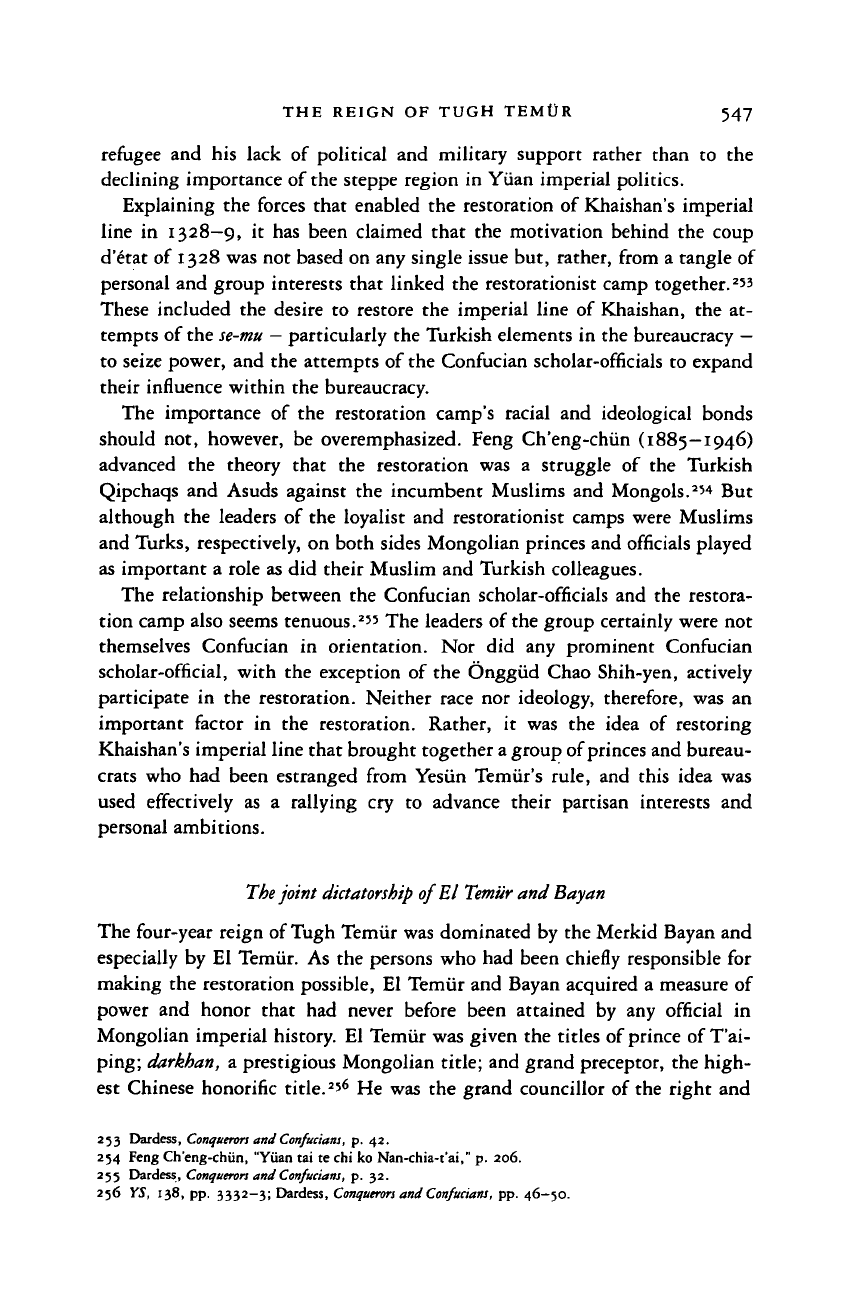
THE REIGN OF TUGH TEMtJR 547
refugee
and his
lack
of
political
and
military support rather than
to the
declining importance of the steppe region in Yuan imperial politics.
Explaining the forces that enabled the restoration
of
Khaishan's imperial
line
in
1328—9,
it
has been claimed that the motivation behind the coup
d'etat
of
1328 was not based on any single issue but, rather, from
a
tangle of
personal and group interests that linked the restorationist camp together.
2
"
These included the desire
to
restore
the
imperial line
of
Khaishan, the
at-
tempts of the
se-mu —
particularly the Turkish elements in the bureaucracy
—
to seize power, and the attempts of the Confucian scholar-officials to expand
their influence within the bureaucracy.
The importance
of
the restoration camp's racial
and
ideological bonds
should not, however,
be
overemphasized. Feng Ch'eng-chiin (1885-1946)
advanced
the
theory that
the
restoration
was a
struggle
of the
Turkish
Qipchaqs and Asuds against the incumbent Muslims and Mongols.
254
But
although the leaders
of
the loyalist and restorationist camps were Muslims
and Turks, respectively, on both sides Mongolian princes and officials played
as important
a
role as did their Muslim and Turkish colleagues.
The relationship between the Confucian scholar-officials and the restora-
tion camp also seems tenuous.
2
" The leaders of the group certainly were not
themselves Confucian
in
orientation.
Nor did any
prominent Confucian
scholar-official, with the exception
of
the Onggiid Chao Shih-yen, actively
participate
in the
restoration. Neither race nor ideology, therefore, was
an
important factor
in the
restoration. Rather,
it was the
idea
of
restoring
Khaishan's imperial line that brought together a group of princes and bureau-
crats who had been estranged from Yesiin Temiir's rule, and this idea was
used effectively
as a
rallying
cry to
advance their partisan interests
and
personal ambitions.
The
joint
dictatorship
of El
Temiir
and Bay an
The four-year reign of Tugh Temiir was dominated by the Merkid Bayan and
especially by El Temiir. As the persons who had been chiefly responsible for
making the restoration possible, El Temiir and Bayan acquired
a
measure of
power
and
honor that
had
never before been attained
by any
official
in
Mongolian imperial history. El Temiir was given the titles of prince of T'ai-
ping; darkhan,
a
prestigious Mongolian title; and grand preceptor, the high-
est Chinese honorific title.
2
'
6
He was the grand councillor
of
the right and
253 Dardess,
Conquerors
and
Confucians,
p. 42.
254 Feng Ch'eng-chun, "Yuan tai
te
chi ko Nan-chia-t'ai," p. 206.
255 Dardess,
Conquerors
and
Confucians,
p. 32.
256
YS,
138, pp. 3332-3; Dardess,
Conquerors
and Confucians, pp. 46—50.
Cambridge Histories Online © Cambridge University Press, 2008
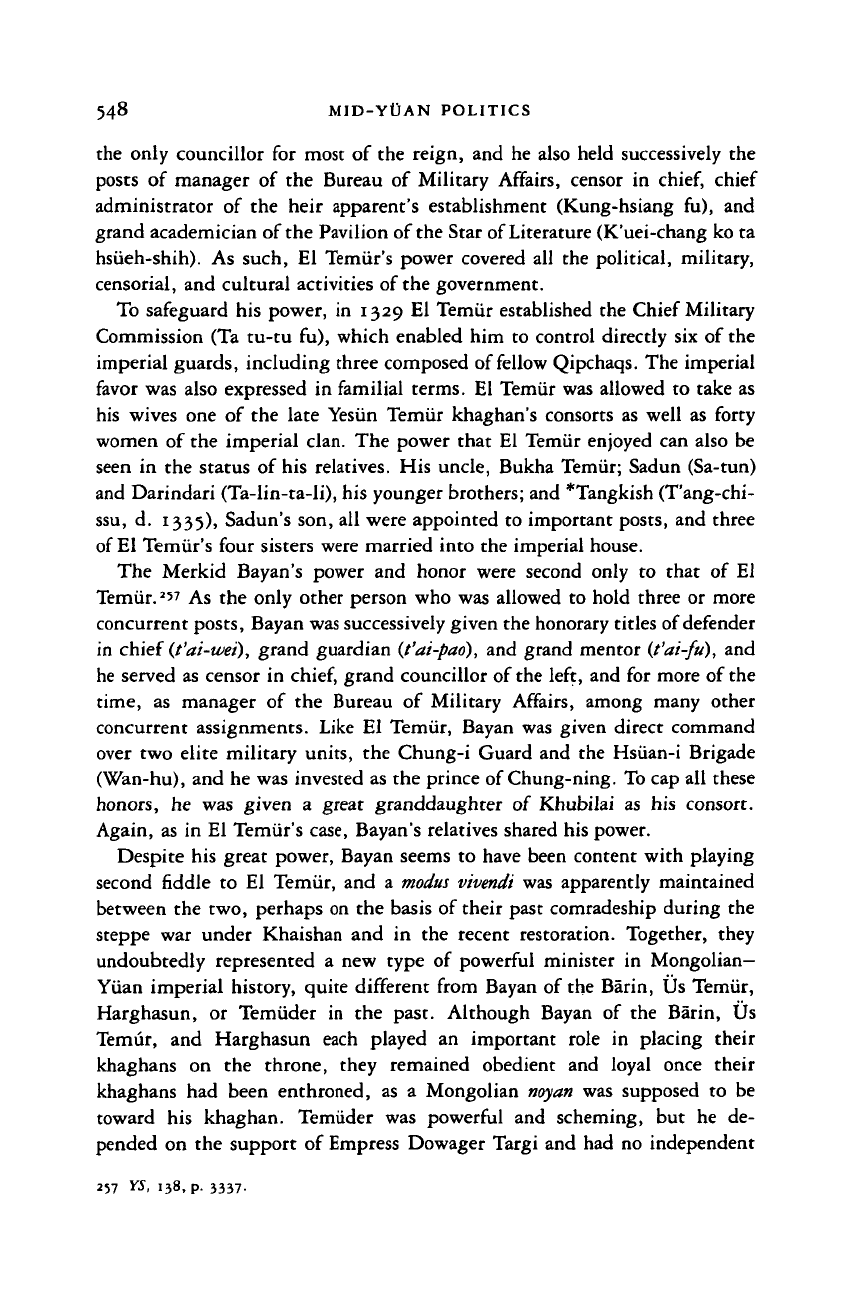
548
MID-YOAN
POLITICS
the only councillor for most of the reign, and he also held successively the
posts of manager of the Bureau of Military Affairs, censor in
chief,
chief
administrator of the heir apparent's establishment (Kung-hsiang fu), and
grand academician of the Pavilion of the Star of Literature (K'uei-chang ko ta
hsiieh-shih). As such, El Temiir's power covered all the political, military,
censorial, and cultural activities of the government.
To safeguard his power, in 1329 El Temiir established the Chief Military
Commission (Ta tu-tu fu), which enabled him to control directly six of the
imperial guards, including three composed of fellow Qipchaqs. The imperial
favor was also expressed in familial terms. El Temiir was allowed to take as
his wives one of the late Yesiin Temiir khaghan's consorts as well as forty
women of the imperial clan. The power that El Temiir enjoyed can also be
seen in the status of his relatives. His uncle, Bukha Temiir; Sadun (Sa-tun)
and Darindari (Ta-lin-ta-li), his younger brothers; and *Tangkish (T'ang-chi-
ssu, d. 1335), Sadun's son, all were appointed to important posts, and three
of El Temiir's four sisters were married into the imperial house.
The Merkid Bayan's power and honor were second only to that of El
Temiir.
2
'
7
As the only other person who was allowed to hold three or more
concurrent posts, Bayan
was
successively given the honorary titles of defender
in chief
(t'ai-wei),
grand guardian
(t'ai-pao),
and grand mentor
(t'ai-fu),
and
he served as censor in
chief,
grand councillor of the left, and for more of the
time,
as manager of the Bureau of Military Affairs, among many other
concurrent assignments. Like El Temiir, Bayan was given direct command
over two elite military units, the Chung-i Guard and the Hsiian-i Brigade
(Wan-hu), and he was invested as the prince of Chung-ning. To cap all these
honors, he was given a great granddaughter of Khubilai as his consort.
Again, as in El Temiir's case, Bayan's relatives shared his power.
Despite his great power, Bayan seems to have been content with playing
second fiddle to El Temiir, and a
modus vivendi
was apparently maintained
between the two, perhaps on the basis of their past comradeship during the
steppe war under Khaishan and in the recent restoration. Together, they
undoubtedly represented a new type of powerful minister in Mongolian-
Yuan imperial history, quite different from Bayan of the Barin, Us Temiir,
Harghasun, or Temiider in the past. Although Bayan of the Barin, Us
Temur, and Harghasun each played an important role in placing their
khaghans on the throne, they remained obedient and loyal once their
khaghans had been enthroned, as a Mongolian
noyan
was supposed to be
toward his khaghan. Temiider was powerful and scheming, but he de-
pended on the support of Empress Dowager Targi and had no independent
257
YS, 138, p.
3337.
Cambridge Histories Online © Cambridge University Press, 2008

THE REIGN OF TUGH TEMl)R 549
power base of his own. By contrast, El Temiir and Bayan were not only
kingmakers in the true sense of the word, but they also built their own
power bases in the bureaucracy and the military. Throughout his short
reign, they overshadowed Tugh Temiir, whose role was mainly restricted to
that of nominal emperor, symbol of legitimacy, and dispenser of titles and
honors.
Political development and fiscal policies
Coming to power through a coup d'etat in the name of restoring Khaishan's
imperial line, Tugh Temiir's administration carried out a bloody purge
against its enemies and made some moves to justify the name of the restora-
tion. The purge against the supporters of Yesiin Temiir's heir was carried out
thoroughly and mercilessly after the surrender of Shang-tu in November
1328.
Not only were the leading loyalists killed or exiled, but their proper-
ties also were confiscated.
2
'
8
This vengeful spirit was so pervasive in the court
that there was even a suggestion to kill all the officials who had followed
Yesiin Temiir on his annual trip to Shang-tu.
2
'
9
In addition, to make Yesiin Temiir's line illegitimate, not only was the
khaghan denied a posthumous temple name, but the chamber in the Imperial
Shrine where the tablet of Kammala, Yesiin Temiir's father, had been placed
also was destroyed. Furthermore, the purge was extended to Khoshila's
followers. Khoshila's three senior supporters who had survived their lord's
murder were either executed or dismissed from office in 1330 on one ground
or another.
260
To justify the restoration, *Baidasha (Po-ta-sha, d. 1332), the commis-
sioner of palace provisions in Khaishan's administration, and Yeh-erh-chi-ni,
Khaishan's manager of the Bureau of Military Affairs, were made honorific
grand mentor and defender in
chief,
respectively.
2&l
Moreover, the honors of
San-pao nu and Toghto, the senior minister in Khaishan's Department of
State Affairs who had been executed and vilified by Ayurbarwada khaghan,
were restored and their confiscated properties returned to their families.
Apart from the old followers of Khaishan, the participants in the restoration
were given most of the positions of importance in the administration.
Significantly, because Yesiin Temur's administration had been marked by
the dominance of Muslims, not one single Muslim held a position in Tugh
Temur's central government, and only a few held posts in the provincial
258 YS, 32, pp. 716-24.
259 YS, 175, p. 4096.
260 YS, 34, pp. 759, 761, 766.
261 YS, no, p. 3792; 124, p. 3058; T'u,
Meng-wu-erh
ihihchi,
156, pp. nb-i2a.
Cambridge Histories Online © Cambridge University Press, 2008
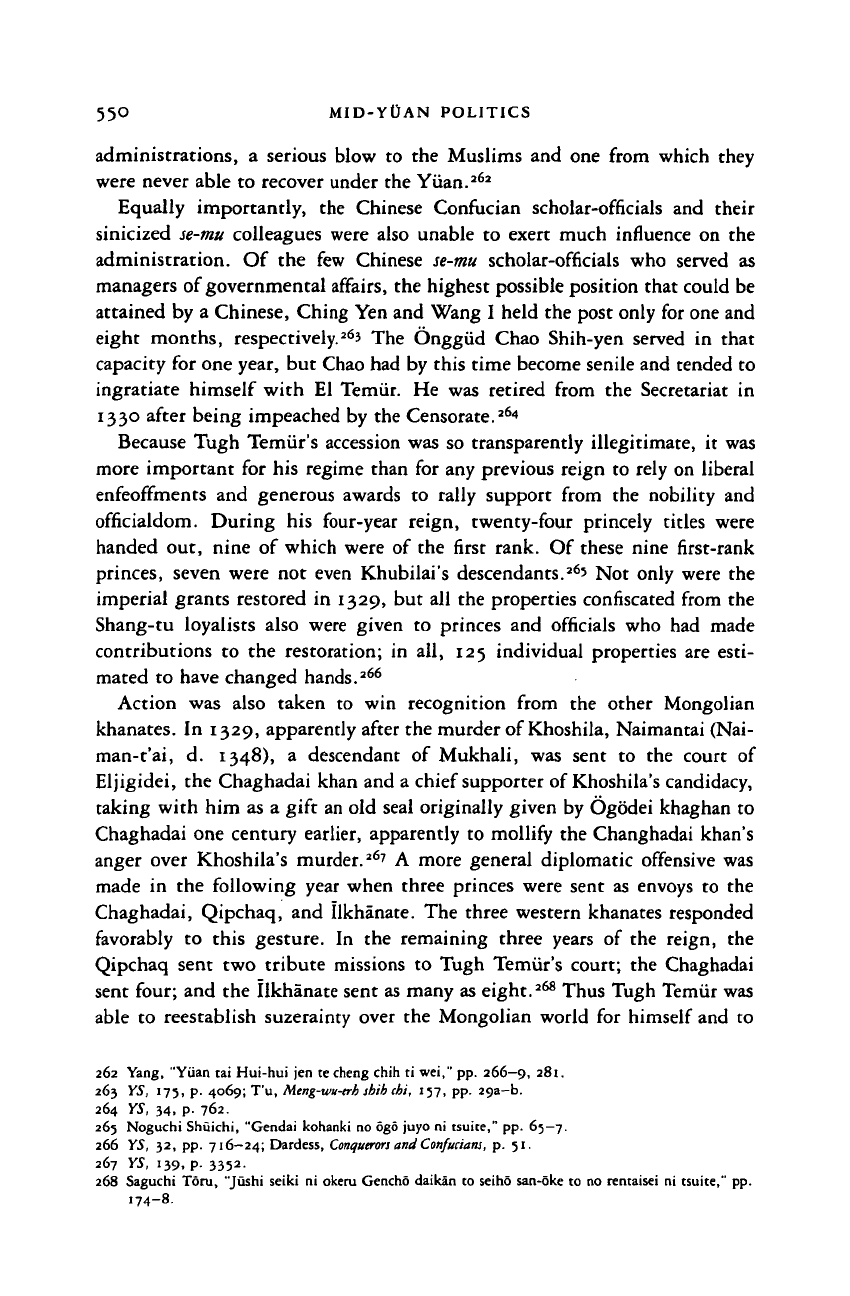
55° MID-YOAN POLITICS
administrations, a serious blow to the Muslims and one from which they
were never able to recover under the Yiian.
262
Equally importantly, the Chinese Confucian scholar-officials and their
sinicized
se-mu
colleagues were also unable to exert much influence on the
administration. Of the few Chinese
se-mu
scholar-officials who served as
managers of governmental affairs, the highest possible position that could be
attained by a Chinese, Ching Yen and Wang I held the post only for one and
eight months, respectively.
26
3 The Onggiid Chao Shih-yen served in that
capacity for one year, but Chao had by this time become senile and tended to
ingratiate himself with El Temiir. He was retired from the Secretariat in
1330 after being impeached by the Censorate.
264
Because Tugh Temiir's accession was so transparently illegitimate, it was
more important for his regime than for any previous reign to rely on liberal
enfeoffments and generous awards to rally support from the nobility and
officialdom. During his four-year reign, twenty-four princely titles were
handed out, nine of which were of the first rank. Of these nine first-rank
princes, seven were not even Khubilai's descendants.
26
' Not only were the
imperial grants restored in 1329, but all the properties confiscated from the
Shang-tu loyalists also were given to princes and officials who had made
contributions to the restoration; in all, 125 individual properties are esti-
mated to have changed hands.
266
Action was also taken to win recognition from the other Mongolian
khanates. In 1329, apparently after the murder of Khoshila, Naimantai (Nai-
man-t'ai, d. 1348), a descendant of Mukhali, was sent to the court of
Eljigidei, the Chaghadai khan and a chief supporter of Khoshila's candidacy,
taking with him as a gift an old seal originally given by Ogodei khaghan to
Chaghadai one century earlier, apparently to mollify the Changhadai khan's
anger over Khoshila's murder.
267
A more general diplomatic offensive was
made in the following year when three princes were sent as envoys to the
Chaghadai, Qipchaq, and Ilkhanate. The three western khanates responded
favorably to this gesture. In the remaining three years of the reign, the
Qipchaq sent two tribute missions to Tugh Temiir's court; the Chaghadai
sent four; and the Ilkhanate sent as many as eight.
268
Thus Tugh Temiir was
able to reestablish suzerainty over the Mongolian world for himself and to
262 Yang, "Yuan tai Hui-hui jen te cheng chih ti wei," pp. 266—9,
2
8l.
263 YS, 175, p. 4069; T'u, Meng-wu-trh shib cbi, 157, pp. 29a—b.
264 YS, 34, p. 762.
265 Noguchi Shuichi, "Gendai kohanki no 6g6 juyo ni tsuite," pp. 65-7.
266 YS, 32, pp. 716—24; Dardess,
Conquerors
and
Confucians,
p. 51.
267 YS, 139. P- 3352-
268 Saguchi Tom, "Jushi seiki ni okeru Gencho daikan to seiho san-oke to no rentaisei ni tsuite," pp.
174-8.
Cambridge Histories Online © Cambridge University Press, 2008
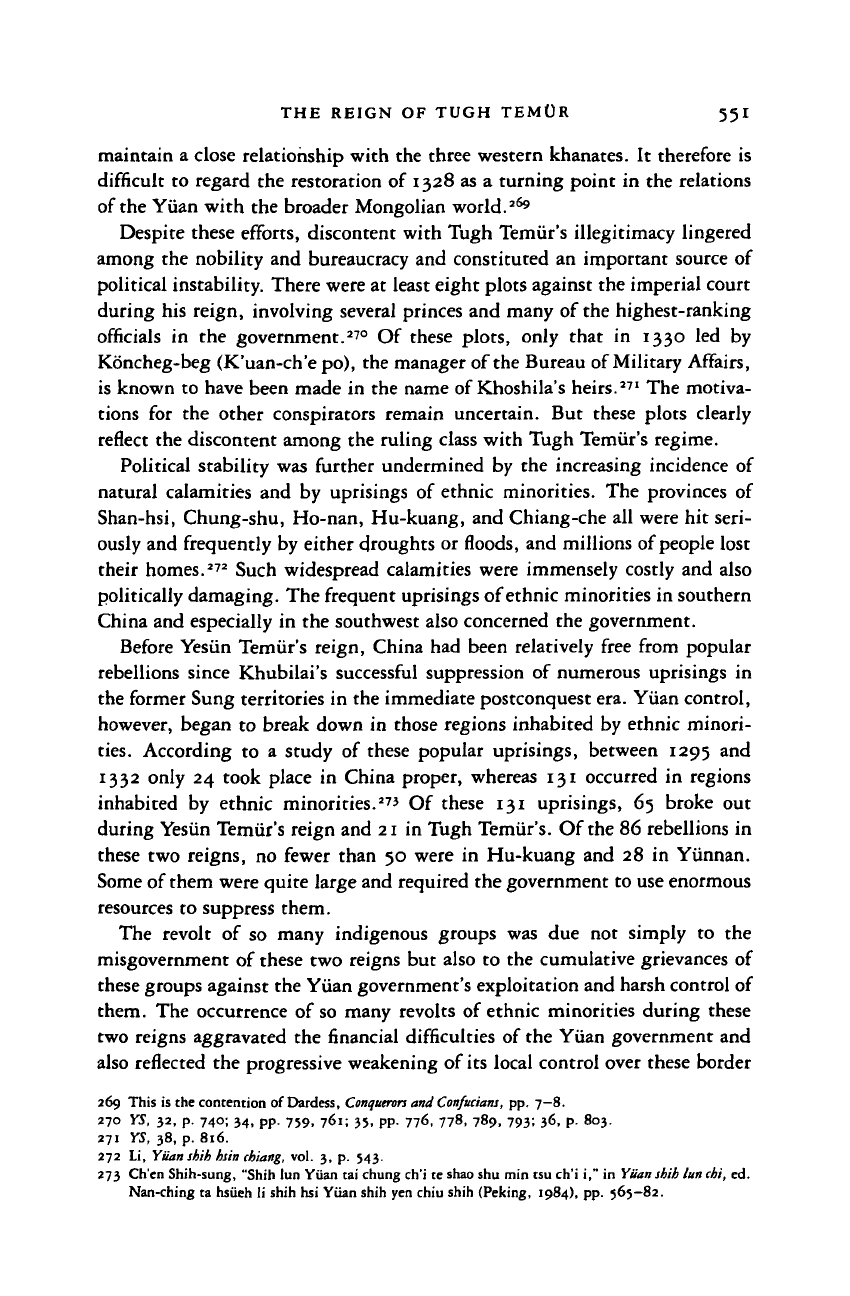
THE REIGN OF TUGH TEMOR 551
maintain a close relationship with the three western khanates. It therefore is
difficult to regard the restoration of 1328 as a turning point in the relations
of the Yuan with the broader Mongolian world.
269
Despite these efforts, discontent with Tugh Temiir's illegitimacy lingered
among the nobility and bureaucracy and constituted an important source of
political instability. There were at least eight plots against the imperial court
during his reign, involving several princes and many of the highest-ranking
officials in the government.
270
Of these plots, only that in 1330 led by
Koncheg-beg (K'uan-ch'e po), the manager of the Bureau of Military Affairs,
is known to have been made in the name of Khoshila's heirs.
271
The motiva-
tions for the other conspirators remain uncertain. But these plots clearly
reflect the discontent among the ruling class with Tugh Temiir's regime.
Political stability was further undermined by the increasing incidence of
natural calamities and by uprisings of ethnic minorities. The provinces of
Shan-hsi, Chung-shu, Ho-nan, Hu-kuang, and Chiang-che all were hit seri-
ously and frequently by either droughts or floods, and millions of people lost
their homes.
272
Such widespread calamities were immensely costly and also
politically damaging. The frequent uprisings of ethnic minorities in southern
China and especially in the southwest also concerned the government.
Before Yesiin Temiir's reign, China had been relatively free from popular
rebellions since Khubilai's successful suppression of numerous uprisings in
the former Sung territories in the immediate postconquest era. Yuan control,
however, began to break down in those regions inhabited by ethnic minori-
ties.
According to a study of these popular uprisings, between 1295 and
1332 only 24 took place in China proper, whereas 131 occurred in regions
inhabited by ethnic minorities.
2
" Of these 131 uprisings, 65 broke out
during Yesiin Temiir's reign and 21 in Tugh Temiir's. Of the 86 rebellions in
these two reigns, no fewer than 50 were in Hu-kuang and 28 in Yiinnan.
Some of them were quite large and required the government to use enormous
resources to suppress them.
The revolt of so many indigenous groups was due not simply to the
misgovernment of these two reigns but also to the cumulative grievances of
these groups against the Yiian government's exploitation and harsh control of
them. The occurrence of so many revolts of ethnic minorities during these
two reigns aggravated the financial difficulties of the Yiian government and
also reflected the progressive weakening of its local control over these border
269 This is the contention of Dardess,
Conquerors
and
Confucians,
pp. 7—8.
270 YS, 32, p. 740; 34, pp. 759, 761; 35, pp. 776. 778, 789, 793; 36. P- 803.
271 YS, 38, p. 816.
272 Li, Yuan shih hsin chiang, vol. 3, p. 543.
273 Ch'en Shih-sung, "Shih lun Yiian tai chung ch'i te shao shu min tsu ch'i i," in Yiian shih lun chi, ed.
Nan-ching ta hsiieh li shih hsi Yiian shih yen chiu shih (Peking, 1984), pp. 565—82.
Cambridge Histories Online © Cambridge University Press, 2008
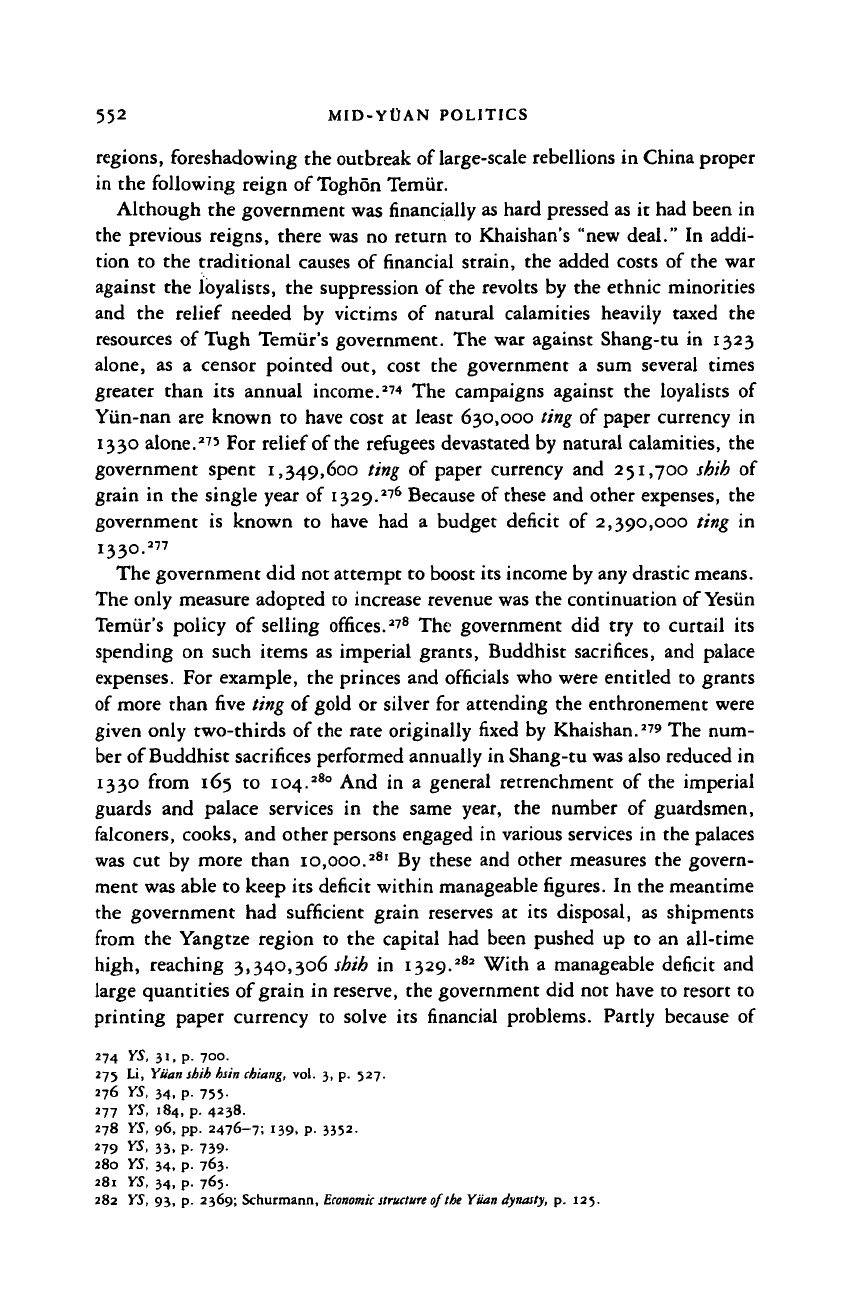
55
2
MID-YOAN POLITICS
regions, foreshadowing the outbreak
of
large-scale rebellions
in
China proper
in
the
following reign
of
Toghon Temiir.
Although
the
government was
financially
as hard pressed as
it had
been
in
the previous reigns, there was
no
return
to
Khaishan's
"new
deal."
In
addi-
tion
to the
traditional causes
of
financial strain,
the
added costs
of the war
against
the
loyalists,
the
suppression
of
the revolts
by the
ethnic minorities
and
the
relief needed
by
victims
of
natural calamities heavily taxed
the
resources
of
Tugh Temiir's government.
The war
against Shang-tu
in 1323
alone,
as a
censor pointed
out,
cost
the
government
a sum
several times
greater than
its
annual income.
274
The
campaigns against
the
loyalists
of
Yiin-nan
are
known
to
have cost
at
least 630,000 ting
of
paper currency
in
1330 alone.
275
For
relief
of
the
refugees devastated
by
natural calamities,
the
government spent
1,349,600
ting
of
paper currency
and
251,700 sbih
of
grain
in the
single year
of
1329.
276
Because
of
these
and
other expenses,
the
government
is
known
to
have
had a
budget deficit
of
2,390,000 ting
in
1330.
277
The government
did
not attempt
to
boost
its
income by any drastic means.
The only measure adopted
to
increase revenue was
the
continuation of
Yesiin
Temiir's policy
of
selling offices.
278
The
government
did try to
curtail
its
spending
on
such items
as
imperial grants, Buddhist sacrifices,
and
palace
expenses.
For
example,
the
princes
and
officials
who
were entitled
to
grants
of more than five ting
of
gold
or
silver
for
attending
the
enthronement were
given only two-thirds
of
the rate originally fixed
by
Khaishan.
2
™ The
num-
ber
of
Buddhist sacrifices performed annually
in
Shang-tu was also reduced
in
1330 from
165 to
104.
280
And in a
general retrenchment
of the
imperial
guards
and
palace services
in the
same year,
the
number
of
guardsmen,
falconers, cooks,
and
other persons engaged
in
various services
in
the palaces
was
cut by
more than 10,000.
28
'
By
these
and
other measures
the
govern-
ment was able
to
keep
its
deficit within manageable figures.
In the
meantime
the government
had
sufficient grain reserves
at its
disposal,
as
shipments
from
the
Yangtze region
to the
capital
had
been pushed
up to an
all-time
high, reaching 3,340,306 shih
in
1329.
282
With
a
manageable deficit
and
large quantities
of
grain
in
reserve,
the
government
did not
have
to
resort
to
printing paper currency
to
solve
its
financial problems. Partly because
of
274
YS, 31, p. 700.
275
Li,
Yuan
shih fain
chiang,
vol. 3, p. 527.
276 YS, 34, p. 755.
277 YS, 184, p. 4238.
278 YS, 96, pp. 2476-7; 139, p. 3352.
279 VS, 33, p. 739-
280 YS, 34, p. 763.
281 YS, 34, p. 765.
282 YS, 93, p.
2369; Schurmann,
Economic structure
of the Yuan dynasty,
p. 125.
Cambridge Histories Online © Cambridge University Press, 2008
